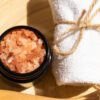Why is Bamboo Salt Spreading Across the World?
What is Bamboo Salt?
Bamboo Salt aka Jukyeom is known as Swom in Tripura’s Kokborok language. Almost 1,000 years ago, Korean doctors and monks developed this salt to use as a remedy for various illnesses, and more importantly, the process of making the salt remains similar, with just a few changes.
The salt is developed by putting sea salt into cases made from bamboo trunks with three years of growth. After that, the cases are sealed with natural, mineral-rich yellow clay. They are then roasted for 10 hours between 1,000-1,500 degrees celsius in a furnace with wood or bamboo used as fuel. In ancient times, the process was repeated only two or three times. However, it was discovered by those doctors through repeated experimentation that Bamboo Salt gained higher medical effectiveness if it was baked for more time. This repeated baking process enhanced the amalgamation of minerals from the bamboo and the yellow clay into the sea salt too.
Jamatia shares many benefits of bamboo salt. It can reduce toothache when applied onto a decaying tooth, or if gargled with water. It also helps with hair loss, getting rid of body odour and relieving Sinusitis. Applying bamboo salt onto skin or washing the skin with bamboo salt water improves skin.
The Spread of Bamboo Salt to India
And this is why one Tripura resident took it upon himself to get into making bamboo salt. Samir Jamatia, a resident of the Gomati district in Tripura, has pedigree when it comes to working with bamboo. As a skilled bamboo technologist who was trained in China, Jamatia has worked with the National Bamboo Mission and the Bamboo Society of India in the past.
It helps that his home state, Tripura, grows 21 species of bamboo in over 3,246 sq/km of forests and planned forestry. Jamatia has been involved with several innovative bamboo-based products, like bamboo rice, bamboo tea, bamboo salt and even utensils made out of bamboo waste.
While Bamboo salt has enjoyed a revival of late, Jamatia has been working with bamboo for over a decade. He visited China in 2009, where he was pursuing a diploma in bamboo-based products, Jamatia told EastMojo. This explains his encyclopaedic knowledge of bamboo, especially Bamboo salt.
Medicinal Properties of Bamboo Salt
Bamboo salt, as a functional food, originated in Korea. Approximately 1,000 years ago, Korean doctors and monks began creating medical salt. The bamboo salt was prepared by putting sea salt into a case made from young bamboo, which had grown for just 3 years. The two ends were sealed using natural red clay and the bamboo case was baked at 1,000–1,500°C (1,2), using pine as the fuel. In ancient times, the bamboo salt was baked only 2-3 times. The salt was then used as a special medical treatment. Eventually, it was identified that bamboo salt acted at its highest medical efficacy if it was baked at least 9 times. The 9-times-baked bamboo salt was named purple bamboo salt. Additionally, it was observed that if bamboo salt is completely melted, the toxic characteristic of the salt disappeared.
Currently, bamboo salt is one of the most well-known traditional medical treatments, not only in Korea but also in a number of other Asian countries (3,4). Bamboo salt contains >70 essential minerals and micronutrients. Pharmaceutical scientists are researching the special therapeutic qualities of bamboo salt, including its anticancer and antiviral effects (5). The researchers noted that bamboo salt demonstrates anti-inflammatory and antioxidant effects and that it may also be used as bamboo salt toothpaste for dental disease and oral hygiene (6,7).
Buccal mucosa cancer is the most common cancer of the oral cavity (8). In the present study, the cancer-preventive effect of purple bamboo salt was evaluated using a mouse model of buccal mucosa cancer. The bamboo salt was shown to enhance anti-cancer activities and the anti-metastatic effect in mice. As a functional food, purple bamboo salt demonstrated oral health benefits in mice.





